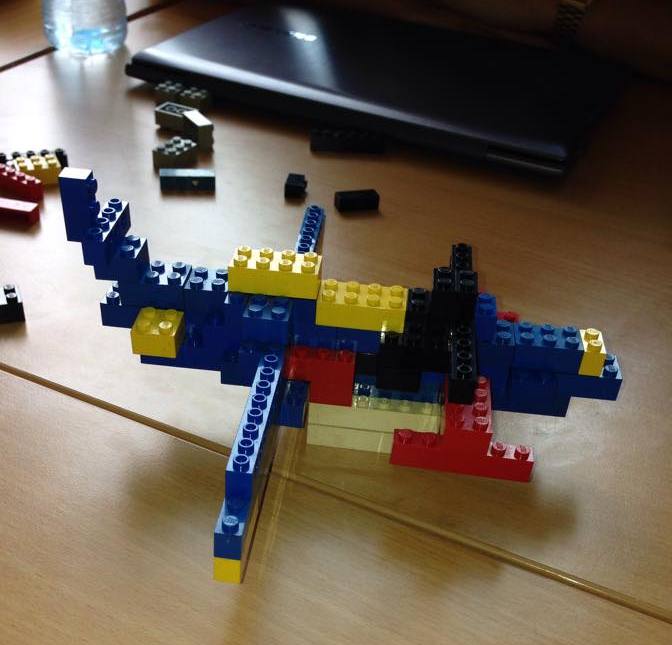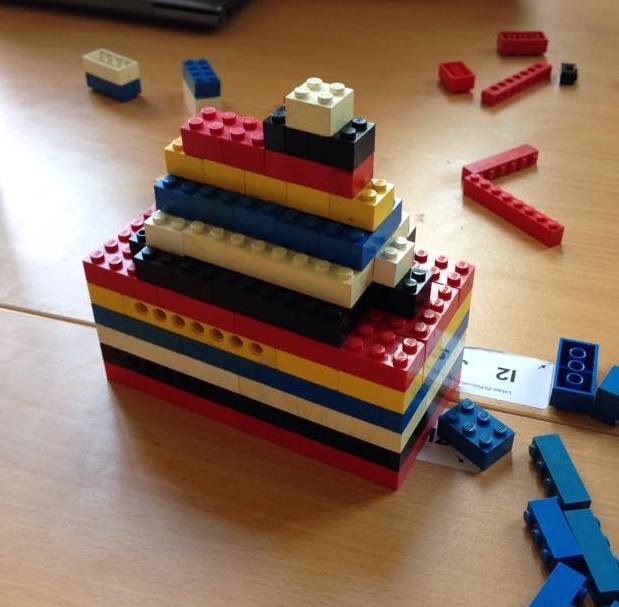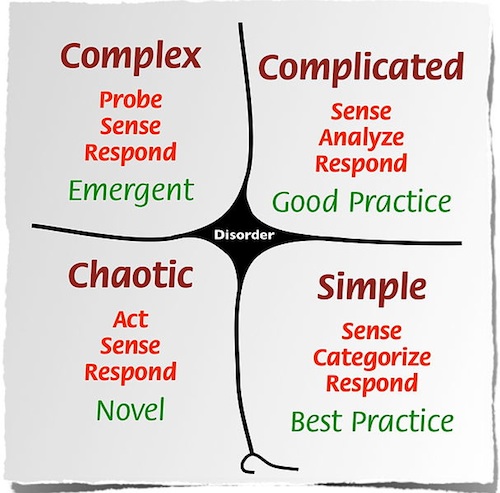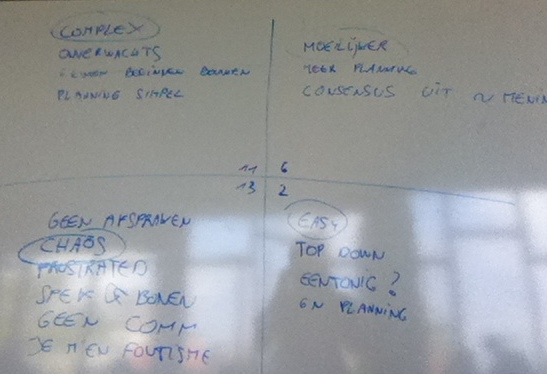
Why do agile and lean work so well in digital advertising projects? Because they are very well suited for complex environments, where it is difficult to predict upfront how a project is going to roll out. And digital advertising work is by its very nature complex.
To make this year’s students at the Belgian Ad School aware of this, I introduced them to the concept “complexity” by using the Cynefin Lego Game.
How does it work? First I divided the student in 4 groups of approximately 7 students, and I gave them an equal amount of Lego blocks in different shapes and colours.
Simple
For the first exercise, they had to sort the blocks based on colour. If they encountered “special” blocks, they could put them in a separate pile in the middle of the table.

This exercise is a simulation of a simple environment, where – to use cynefin terminology – everything happens in the following order: sense, categorize, respond.
As a team you are told what to do, you build categories of tasks (in this case everybody picked a colour) and you perform the tasks. The end. You could compare it to a match factory where one person has to fold the boxes, another one has to put the matches in the boxes, and the third person has to put the matchboxes in bigger boxes so they can be delivered to the stores.
When asked about their feelings after the first exercise, the students came up with:
- easy
- no planning
- top down decision making (one person proposed a plan, which was picked)
- monotonous
Complicated
The second exercise requires the students to make a sculpture with the following rules: at least 20 bricks high, with a regular colour pattern, every block can’t be bigger than the one below it.

This exercise simulates a complicated environment. First you sense the task, then different people in the team propose a solution. After analysis, an approach is chosen, and the team responds by performing the task. The biggest difference in regard to the simple exercise, is that there is not one best practice to do this, but different good practices are possible.
The students’ reaction on the second exercise was:
- more difficult
- more planning
- a consensus after hearing different opinions
The complicated context is a perfect analogy for e.g. doing a direct marketing mailing. There are different ways of doing it, but when you establish your approach up front, it is pretty straight forward to perform these steps. The causality between start and end of the project is pretty easy to determine in advance.
Complex
For the complex exercise, the students had 30 seconds to decide if they would make an animal or a vehicle.
Then they had to stop talking, and the following rules were layed out: the same regular colour pattern as in the previous exercise, every team member could only touch one colour of bricks.
Also, every couple of minutes, the team had to switch tables, taking their unfinished work with them – but not the bricks.
You’ll notice that the end result from one of the teams was a pretty obvious plane. (Yes they made a free interpretation of the “regular colour pattern”, but creative solutions are to be applauded.)

In this complex environment simulation, there is only limited time for planning. The team has to go ahead with a plan (probe), sense if it is working, and respond base on how they progress.
This is the perfect metaphor for digital production work. There is in advance no clear causality between the start of the project and where you will end up. You just choose an approach, and change your plans while you progress. Also notice the parallels with Plan-Do-Check-Act (from Lean thinking) or Build-Measure-Learn (from the Lean Startup).
How did this feel? The students said:
- just starting to build was a good approach
- a lot of unexpected things happened
- planning wasn’t that hard
Chaos
In the final exercise, the students had to remain silent the whole time and they couldn’t plan for 30 seconds. Rules were similar to the previous exercise, however this time they had to build a monument.
Also, at random moments I asked people to switch teams and join another table.
What happened? The end results were rather poor. For example the monument below, which was supposed to represent a church, but didn’t have any windows or an entrance.

Some of the students got really annoyed during this final exercise. Especially the random team switches were particularly frustrating. Some of them even checked out after a while, or started throwing their bricks on the table, mildly frustrated.
Or in their words:
- frustration
- no communication
- no movitation (“je m’en foutism”)
- chaos
This chaotic exercise is what you should try to avoid when doing digital projects. No planning, constant resource switching, no communication, frustration, lack of motivation, bad end results,…
Whereas practices in the complex exercise where emergent (based on what happens), the practices in the chaotic exercise were novel. Which means they aren’t really based on what the team learns along the way, but rather random solutions without much thinking or motivation.
Summary: Cynefin Lego Game
When you compare the Cynefin Model with how the students felt after each exercise, you see a pretty good correlation.
The Cynefin Model

What the students said after each exercise:
 Also notice the time increase for each task from 2 minutes to 13 minutes.
Also notice the time increase for each task from 2 minutes to 13 minutes.
Bottom line: digital advertising projects will force you to work in complex environments, where there is no clear causality between what you end up with and how you started your project. If you want to make this work, you need an approach where your process is lightweight and flexible. An agile approach basically, where you constantly pivot based on learnings during the project. The biggest risk is that your complex environment becomes chaotic, where there is no planning, constant resource switching and at random behavior. This Lego Cynefin Game enables you to make people actually feel the difference between complex and chaotic.
P.S. Many thanks to the students of Belgian Ad School for sending me some pictures to use in this blogpost.
You want to read more about complexity?
